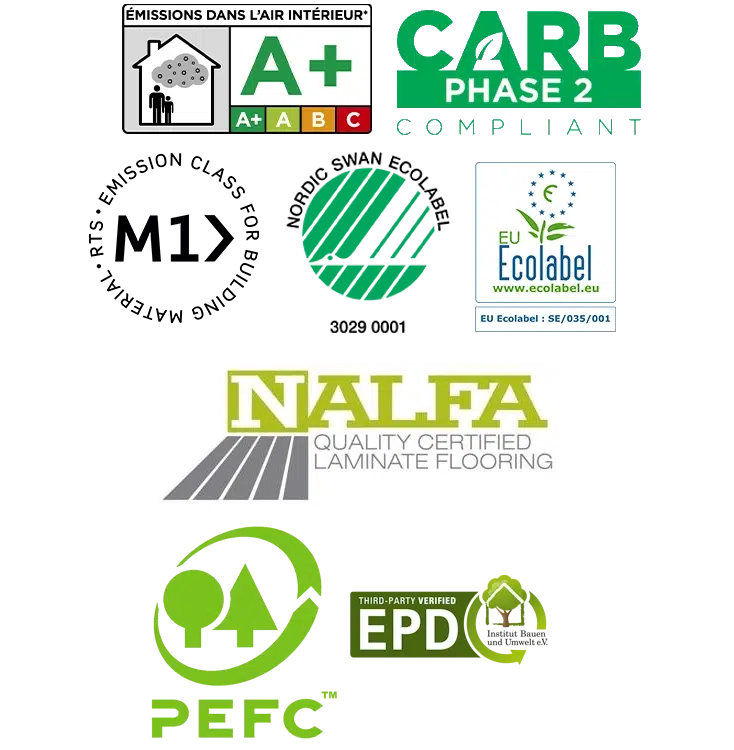Flooring Certifications. What are they? What do they mean?
As environmental consciousness continues to grow, homeowners are increasingly seeking eco-friendly and sustainable options for their living spaces. One crucial aspect of a sustainable home is the choice of flooring materials. In this blog post, we’ll explore various certifications that ensure the eco-friendliness and sustainability of flooring products. Each certification represents a commitment to environmental responsibility, health standards, and ethical sourcing. Let’s dive into the world of flooring certifications:
1. FSC (Forest Stewardship Council):
The FSC certification is a mark of responsibly sourced wood and forest products. Flooring bearing the FSC label indicates that the wood comes from well-managed forests that meet rigorous environmental and social standards. Choosing FSC-certified flooring helps conserve biodiversity and supports local communities.
2. A+ Flooring Certifications:
In the context of flooring, the A+ certification often refers to indoor air quality. This certification ensures that the flooring materials emit minimal volatile organic compounds (VOCs), contributing to healthier indoor air. A+ certified flooring is an excellent choice for homes, as it reduces the risk of respiratory issues and improves overall indoor air quality.
3. M1 Emission Class:
Originating from Finland, the M1 emission class is a standard for building materials that signifies low emissions of formaldehyde and other harmful substances. Flooring with M1 certification contributes to a healthier indoor environment by minimizing the release of pollutants.
4. PEFC (Programme for the Endorsement of Forest Certification):
Similar to FSC, PEFC is a global certification system for sustainable forestry. PEFC-certified flooring ensures that the wood used comes from responsibly managed forests, promoting environmental conservation and supporting ethical practices.
5. EU Ecolabel:
The EU Ecolabel is a mark of environmental excellence awarded to products with a reduced environmental impact throughout their lifecycle. Flooring with the EU Ecolabel meets strict criteria for resource efficiency, emissions, and overall environmental performance.
6. EPD (Environmental Product Declaration):
EPD is a comprehensive declaration that provides information on a product’s environmental impact. EPD-certified flooring discloses data on energy consumption, emissions, and resource usage, helping consumers make informed choices based on the product’s sustainability.
7. Nordic Swan Ecolabel:
The Nordic Swan Ecolabel is a certification that guarantees a product’s compliance with stringent environmental and health criteria. Flooring carrying the Nordic Swan Ecolabel is produced with minimal impact on the environment and adheres to strict quality standards.
8. Nalfa (North American Laminate Flooring Association):
Nalfa certification is specific to laminate flooring. Products with Nalfa certification meet industry standards for performance, durability, and indoor air quality, providing consumers with assurance regarding the quality and sustainability of their laminate flooring.
9. US Green Building Council (USGBC):
The USGBC’s Leadership in Energy and Environmental Design (LEED) certification is widely recognized for sustainable building practices. Flooring materials that contribute to LEED certification help homeowners achieve a higher level of sustainability in their homes.
10. CARB Phase 2:
The California Air Resources Board (CARB) Phase 2 certification sets limits on formaldehyde emissions from composite wood products, including certain types of flooring. Compliance with CARB Phase 2 standards ensures that flooring materials have low formaldehyde emissions, contributing to improved indoor air quality.
11. Floorscore Flooring Certifications:
Floorscore is a certification program that focuses on indoor air quality and VOC emissions. Flooring with Floorscore certification undergoes testing to ensure it meets strict standards for low emissions, providing a healthier living environment.
Flooring Certifications Conclusion:
When choosing flooring for your home, consider the impact on the environment and indoor air quality. Certifications such as FSC, A+, M1, PEFC, EU Ecolabel, EPD, Nordic Swan Ecolabel, Nalfa, US Green Building Council, CARB Phase 2, and Floorscore serve as valuable indicators of a product’s commitment to sustainability and health. By opting for certified flooring, you not only contribute to a greener planet but also create a healthier and more sustainable living space for you and your family.


